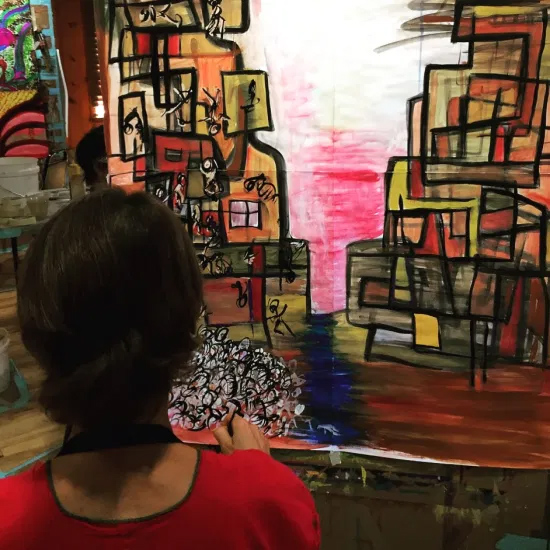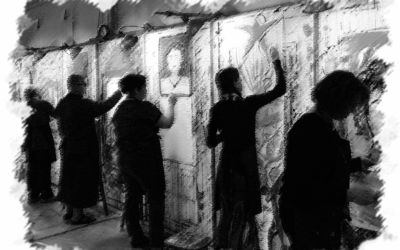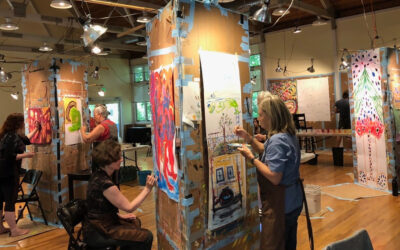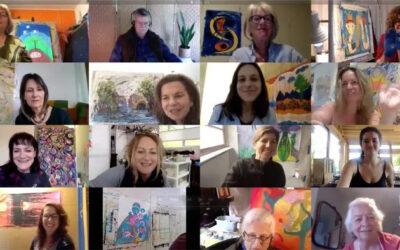
“An important time to paint is when you resist it the most. The strength of the aversion means that there is something just beneath the surface, thinly disguised, ready to emerge. Resistance is a reminder to probe your inner fears and defenses . . . . If you find yourself experiencing resistance, ask: What would I least want to paint right now?” ~ Life, Paint and Passion
We know the value of the painting process but sometimes we find ourselves resisting painting. Sensing a disturbance, we feel blocked, flat, tired or uninspired. It’s difficult to pick up a brush and face this hard, stuck place.
But can we just stand in front of our painting for a few minutes and begin to notice what arises? Is it judgment about the painting, the to-do list that is burning in our brain and distracting us, physical discomfort, or something else? Whatever it is, can we bring our attention to it? What is actually happening in the present moment? And what arises from this place—a feeling, a sensation, a color, a gesture? Can just being in our body in the present take us back into the painting? A few moments of listening to what is calling us internally can help us find a connection back to visual expression. This is a practice, a discipline, and a reminder to ourselves that once we are “in” the flow, it will carry us.
Painting What We Fear
Resistance often arises in those moments when we know what we want to paint—or at least what is appearing in our imagination—but we are afraid to paint it. Strong feelings come up with some images; we might imagine that we will make them worse, or make something come true if we go toward it. Why would we want to paint what we fear?
When we realize fear is already present—it arrived on its own—and we respect the wisdom of its arrival, we can go toward it, we can actually enter the feeling and paint it. Going toward a hard place, a fearful place, means going against our impulses to run, to hide, or to dismiss our feelings. “Going toward” takes courage and also helps us find release. It acknowledges what already exists and liberates us.
We will not make something bad happen by painting it. We only release what is already present in us which, if we were to hold onto it, would likely do more harm by holding it in than painting it out. The paper can hold anything and everything. It is such a good friend.
For more on the topic of meeting fear and allowing uncomfortable feelings while painting, see Working From the Body: Feeling and Painting.

Resistance is an important teacher; it moves us toward our true inspiration. Let’s stand in it and let it teach us!
We Are Not Our Painting
Resistance often comes when we think what is emerging in our imagination means something about us: “I wouldn’t be a person who would paint something violent, I’m not a violent person.”
One important reason we don’t comment on other people’s paintings in our workshops is that we tend to have immediate reactions to the images that appear in both our own paintings and those around us. As a facilitator, we quickly learn that what we might imagine is happening in a painting is not necessarily what is happening for the painter. Holding this place of respect and openness is critically important. What may appear to us as a violent image can be a very important release for the painter.
If we think a painting means something about us—that it identifies us as “a certain kind of person”—it will stop the flow of our creative expression. It is a means of expression much like a dream is. What we paint does not define or contain us. What comes to us to paint comes from somewhere much bigger than how we normally define ourselves. It is unlimited, unprecedented, unpredictable, and quite unknowable. We may recognize tendencies or things in our paintings that are familiar to our life, our behavior, or our feelings, but they are not us; they do not define us. They are fleeting. They keep moving, as we do, as everything does.
Let’s not nail ourselves to a painting and say, “This is me—this is my life.” Let’s keep some mystery alive in the process and respect the depth of the intelligence that is working through us.
For more on this topic, see You Are Not Your Painting!

Annie Rousseau is a Senior Facilitator of The Painting Experience. You can paint with her next in Vancouver, B.C. in January, where she and Stewart Cubley will co-facilitate a workshop on Granville Island. Annie will also be back at Ocean Resort on Vancouver Island from March 16-18, 2018. That workshop will be up on the website and available for registration soon!



